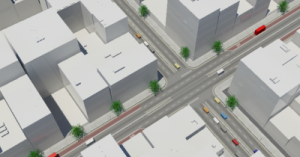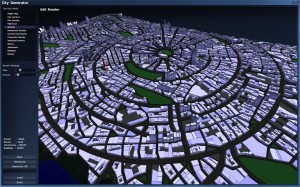To model larger things than your own bedroom in SketchUp, you will need a lot of patience and persistence. And even then, you can’t model how the worlds live and act. No, you’re going to need tools better suited to the job.
 You could take it leisurely and install the one and only city simulator: SimCity. If you want to build cool looking cities like the one on the left, you’ll need one of the new iterations of the game. Or if you don’t mind 80s graphics and the basics, there is a free version of the classic game online. It doesn’t seem to work on FireFox though. But beware of lost hours once you get going.
You could take it leisurely and install the one and only city simulator: SimCity. If you want to build cool looking cities like the one on the left, you’ll need one of the new iterations of the game. Or if you don’t mind 80s graphics and the basics, there is a free version of the classic game online. It doesn’t seem to work on FireFox though. But beware of lost hours once you get going.
SimCity 4 offers you much more advanced gameplay. It has a lot more variables than the classic game, but with it comes added depth. If you manage to master the game in this lifetime, and think it is limited, go and take a look at SimTropolis. The real fans go far beyond what you think is possible with “just” a game. Real cities, real monuments, or stuff that’s far out there. The game can transform to suite every taste.
Be careful, city building will take a lot of your time. Don’t worry about all those gamers loosing time on the boring action game of the moment. You are building a living thing! Or so it seems.
A step away from SimCity’s accessibility are the real developers. Those who take programming seriously. As they say: If you want to create the ultimate city, you got to pay the ultimate price 😉 If you want something visually impressive that “lives”, you will need advanced knowledge of 3D programming and at least some basic knowledge of Artificial Intelligence.
 Smithee at Digital Urban is hosting an entire series of how to use Agent Based Modelling inside 3D modelling applications. In his latest installment he even takes his theories into Second Life. You will need to do a little digging on the CASA site to figure out the algorithms and a lot more work to implement them yourself. But nothing beats the feeling of seeing your creation come to life.
Smithee at Digital Urban is hosting an entire series of how to use Agent Based Modelling inside 3D modelling applications. In his latest installment he even takes his theories into Second Life. You will need to do a little digging on the CASA site to figure out the algorithms and a lot more work to implement them yourself. But nothing beats the feeling of seeing your creation come to life.
Many other universities also have their proper city/world modelling departments. Such as the cities project at the CCL. They use their own NetLogo modelling environment, which is very powerful in the agent modelling department, but a lot less in the graphical department. Maybe some one can make the link between the NetLogo environment and a 3D tool. That would immediately bring it up to par with Digital Urban’s research.
 To finish this extremely short introduction to virtual city building, I’d like to mention one more game producer. It’s Introversion, creator of such innovative games as Darwinia. Judging by their blog entries, they take their work very seriously. For instance, take this post on how cities are generated in Subversion. Obviously, they don’t give you any of the algorithms. But following along their development process is interesting enough. There is a whole set of “It’s all in your head” articles. All are worthy of your attention.
To finish this extremely short introduction to virtual city building, I’d like to mention one more game producer. It’s Introversion, creator of such innovative games as Darwinia. Judging by their blog entries, they take their work very seriously. For instance, take this post on how cities are generated in Subversion. Obviously, they don’t give you any of the algorithms. But following along their development process is interesting enough. There is a whole set of “It’s all in your head” articles. All are worthy of your attention.
BTW, as always, the comments are open: Feel free to add your favourite virtual world to this list.